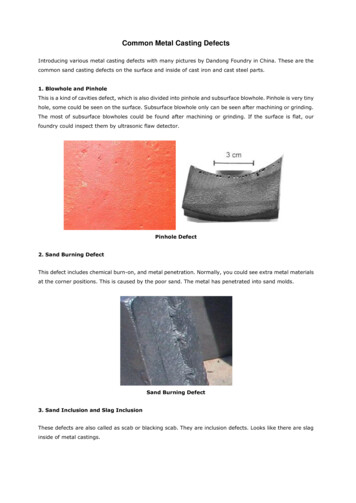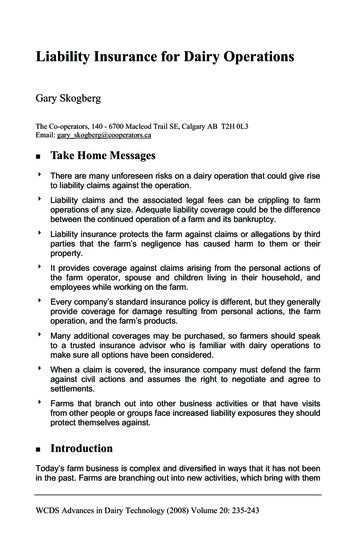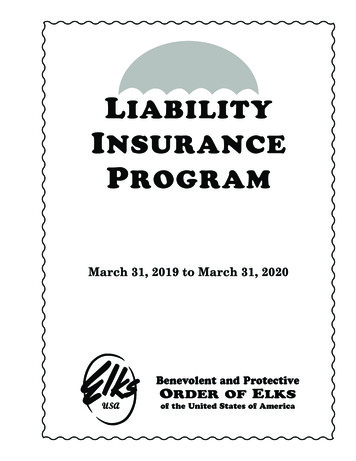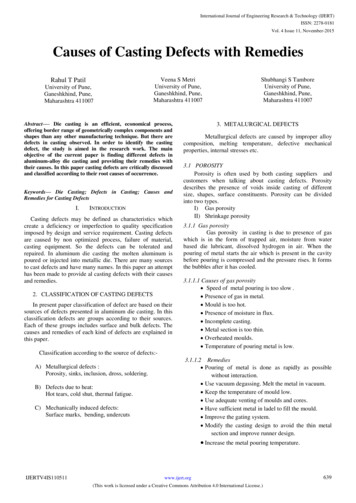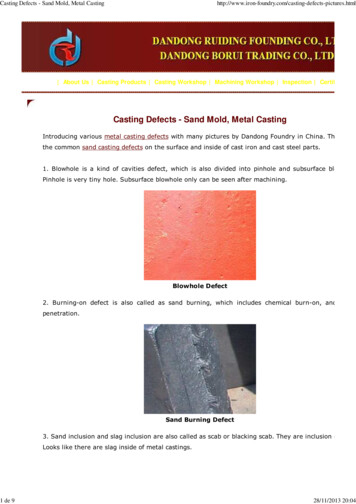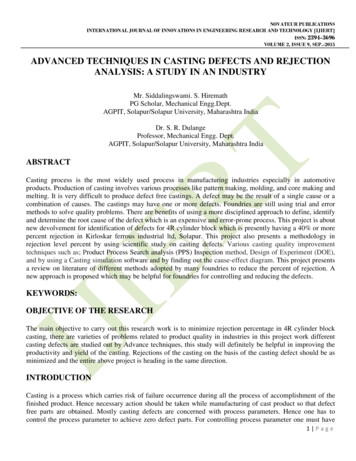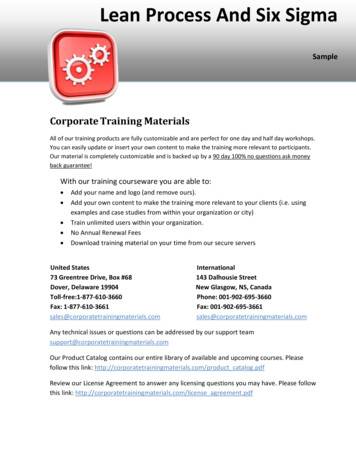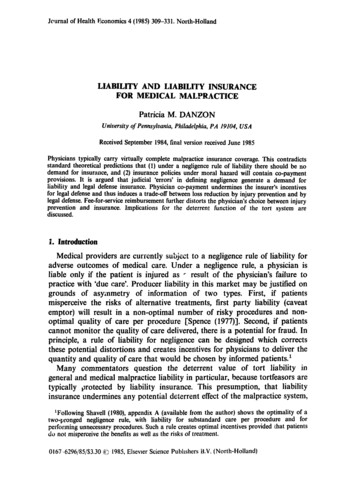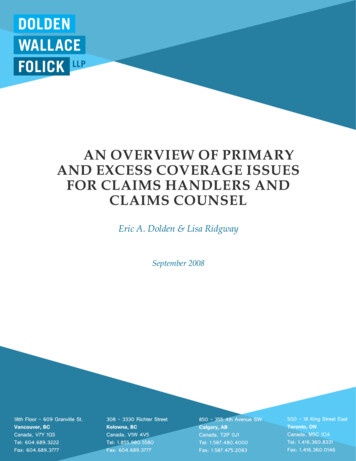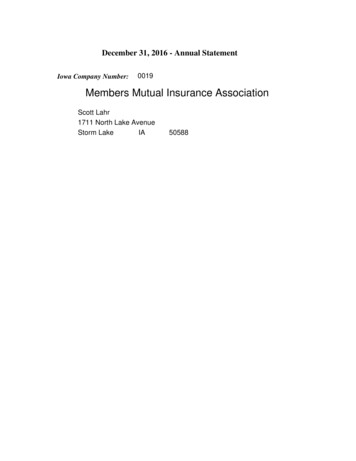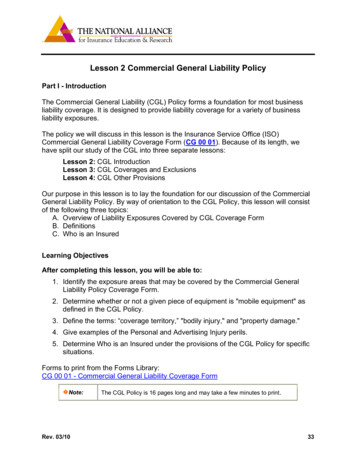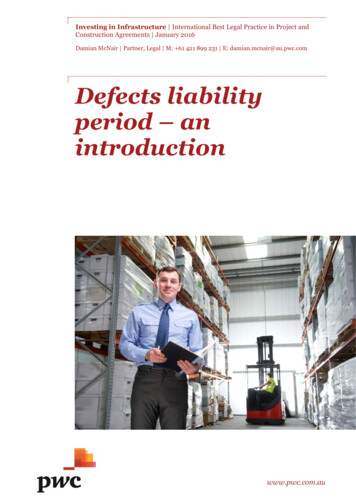
Transcription
Investing in Infrastructure International Best Legal Practice in Project andConstruction Agreements January 2016Damian McNair Partner, Legal M: 61 421 899 231 E: damian.mcnair@au.pwc.comDefects liabilityperiod – anintroductionwww.pwc.com.au
Defects liability period –an introductionConstruction contracts usually include a defects liability period during which the Contractor is responsiblefor repairing or rectifying defects that appear in the works. The period usually commences upon practicalcompletion of the works and runs for a specified time frame (sometimes also known as themaintenance period).This paper discusses the main elements of a defects liability clause and the considerations for negotiating thisclause from both an Employer’s and a Contractor’s perspective.Purpose of a defects liability periodUnder a construction contract, one of the Contractor’s primary obligations is to carry out and complete theworks to the standard set out in the contract. The defects liability period is intended to complement this liabilityby setting out how and when the Contractor must remedy defective work which becomes apparent during thedefects liability period. In effect, the defects liability obligation recognises that defects will arise in the periodfollowing completion and includes the obligation to repair those defects in the general obligation to completethe works to the required standard.The defects liability period provides a practical mechanism to the Employer for the repair or making good ofdefects which may not be apparent before completion, without resorting to dispute resolution. Making theContractor responsible for carrying out the repairs is usually cheaper and more efficient than either theEmployer repairing the defect itself or engaging a third party to repair the defect.In most contracts, the Employer will retain either a proportion of the contract sum (cash) or a reducedperformance bond as surety for performance of the Contractor’s obligations during the defect liability period.Elements of a defects liability clauseA defects liability clause will set out the length of the defects liability period, the scope of defects the Contractoris obliged to remedy and any part of the contract sum retained by the Employer as surety for the performance ofthe remedial work (although this may be dealt with in the general clause dealing with the provision of security).A defects liability clause may also deal with the procedures for notifying the Contractor of the defects, thecircumstances under which the defects liability period may be extended and any caps on such extensions to thedefects liability period.Length of the defects liability periodTypically, the defects liability period starts on the completion of the works, which in many contracts will besignalled by the Employer’s representative’s issue of a practical completion certificate. The actual period willvary depending on the nature of the contract; for straightforward building projects it is usually six or 12months. For complex engineering projects such as a power station, it can be as long as 24 or 36 months. Thedefects liability clause may also provide for sectional completion, for example:The defects liability period is the period of 12 months commencing on the date of practical completion. If theworks are taken over by the Employer in sections, the defects liability period for each section must commenceon the date of practical completion for that section.However, sectional completion is to the Contractor’s benefit. An Owner will not want sectional defects liabilityperiods, but rather will want the period to commence on completion of the last section.PwC3
Defects liability period – an introductionScope of defectsA defects liability clause will require the Contractor to repair or make good defects which are the result of theContractor’s default. Contractors will generally seek to exclude liability for defects not owing to the Contractor’sdefault, for example:The Contractor is not responsible for the repair, replacement or making good of any defect or of any damageto the works arising out of or resulting from any of the following causes:(a)Any acts or omissions of the Employer, its employees, agents and Contractors (other than theContractor).(b)Improper operation or maintenance of the works.(c)Use and operation of the works outside the specification.However, some clauses will require the Contractor to make good defects irrespective of the cause of the defect,with appropriate reimbursement where the Contractor is not in default. This facilitates quick repairs of theworks by the party most familiar with the works and, therefore, best able to undertake the repairs.In some cases, the Contractor may have an absolute liability to make good or repair the defects at its own cost.An example of this is the following clause:If during the defects liability period any defect is found, the Contractor must, promptly and at its cost repair,replace or otherwise make good (in consultation with the Employer) the defect as well as any damage to thefacility caused by the defect. . . The Contractor will bear all incidental costs, including any costs of removalassociated with the repair, replacement or making good of the defect or damage.Defects are generally regarded to include any deficiency in the quality of the works including defects due tofaulty material or workmanship. This may extend to design where it is part of the Contractor’s responsibilities(for example, in EPC Contracts).The defects liability period usually does not include an obligation to repair defects which occur as a result of fairwear and tear. However, for the avoidance of doubt it is prudent, from a Contractor’s perspective, to expresslyspecify this in the defects liability period clause. For example, by adding “ normal wear and tear” to the generalexceptions clause.Contractor’s right to remedy works and notificationsAnother important consideration is determining whether the Contractor has an exclusive right to remedydefects which appear during the defects liability period.From the Contractor’s perspective, it is beneficial to have the exclusive right to remedy the defects during thedefects liability period as the costs of remedying the defects will be cheaper than paying the Employer the costof another Contractor performing such works. If the Contractor has an exclusive right to repair defects, anEmployer who proceeds to remedy the works without offering the Contractor the opportunity to do so will be inbreach of the contract.Of course, the clause may provide for circumstances where the Employer has the right to engage anotherContractor to remedy the defects at the cost of the Contractor, for example:If the Contractor fails to commence the work necessary to remedy the defect or any damage to the facilitycaused by the defect within a time agreed with the Employer under clause [ ], the Employer may proceed todo the work, or engage another party to do the work and the costs, including incidental costs, incurred by theEmployer as a result will be a debt due and payable to the Employer on demand and may be deducted fromany payments otherwise due from the Employer to the Contractor. The Employer may also have recourse tothe security and retention provided under this contract.The Employer is generally required to give the Contractor notice of the defects as soon as practicable, statingthe nature of the defect and supporting evidence.PwC4
Defects liability period – an introductionAustralian courts appear to favour an approach that places a heavy burden upon the Owner to comply with thecontractual bargain and to follow the procedures prescribed under the contract with respect to notification ofdefects once they have been identified, and subsequently allowing the Contractor to rectify the defects.1Extension of defects liability periodIt may be beneficial for the Employer to be able to extend the defects liability period especially wheresubstantial defects occur. This can be achieved by using the following clause:Where the Employer, acting reasonably, considers that substantial repair, replacement or making good ismade under clause [ ], then subject to clause [ ], the defects liability period will be extended by a periodequivalent to the defects liability period, from the date of that repair, replacement or making good but only inrespect of that part of the works so repaired, replaced or made good.The Contractor should seek to ensure that the defects liability period is capped by the inclusion of thisprovision:Despite clause [ ], the total defects liability period must not extend beyond [24] months after the date ofpractical completion. The position under English law is that where the contract is silent on the extension of thedefects liability period, the Contractor's liability continues until it is barred by the Limitation Act 1980 (six to 12years). Under English law, the Contractor may still be liable after a defects liability period ends, under otherexpress terms, including a guarantee, warranty or indemnity.2Common law rightsUnless express words are used, a defects liability clause will generally not affect the parties’ remedies undercommon law. For example, an Employer can sue the Contractor for damages for defects which appear during orafter the defects liability period, though its damages may be limited – if the Employer has acted unreasonably –to the cost of the Contractor performing the remedial works.Nonetheless, the Employer should make this position clear by adopting the following wording:The rights of the Employer under this clause [ ] are in addition to and do not limit any other rights which theEmployer has under this contract or under any law.It should be noted however, that the courts require strict compliance with the procedural steps and noticeprovisions in the contract relating to defects before an Employer can claim damages for defects. The court heldthat a "wider common law right" to engage others and then to claim the costs incurred as damages for breach ofcontract should not fly in the face of those obligations.3ConclusionThis paper is intended to provide a brief overview of the defects liability period and examples of typical clauses.Subsequent updates will deal more closely with specific issues or problems which may arise, particularly wheredefects liability clauses are poorly drafted.1Turner Corporation Ltd (Receiver and Manager Appointed) v Austotel Pty Ltd (1994) 13 BCL 378; Bitannia Pty Ltd v Parkline Constructions Pty Ltd(2010) 26 BCL 335.2Adams v Richardson & Starling Ltd [1969] 1 WLR 1645.3Turner Corporation Ltd (Receiver and Manager Appointed) v Austotel Pty Ltd (1994) 13 BCL 378.PwC5
www.pwc.com.au 2016 PricewaterhouseCoopers. All rights reserved.PwC refers to the Australian member firm, and may sometimes refer to the PwC network.Each member firm is a separate legal entity. Please see www.pwc.com/structure for further details.At PwC Australia our purpose is to build trust in society and solve important problems. We’re anetwork of firms in 157 countries with more than 208,000 people who are committed to deliveringquality in assurance, advisory and tax services. Find out more and tell us what matters to you byvisiting us at www.pwc.com.auLiability limited by a scheme approved under Professional Standards Legislation.
Contractor's right to remedy works and notifications Another important consideration is determining whether the Contractor has an exclusive right to remedy defects which appear during the defects liability period. From the Contractor's perspective, it is beneficial to have the exclusive right to remedy the defects during the
